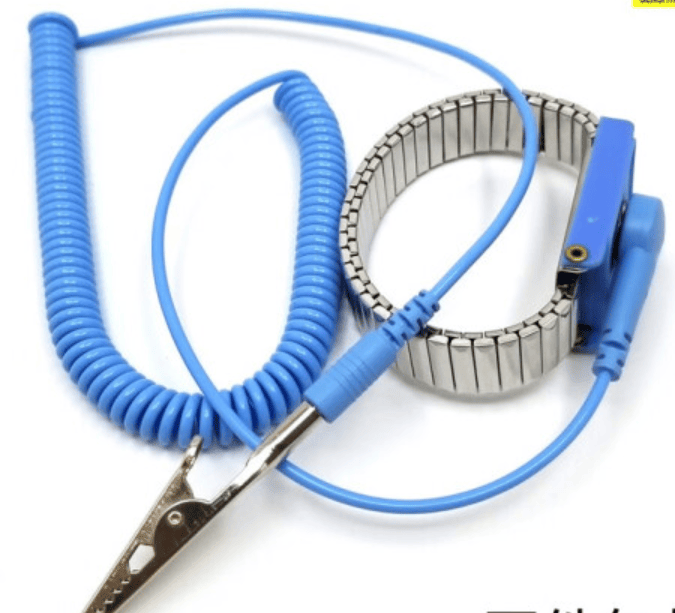Electrostatic Discharge Wrist Strap EF-068-16

Feature:
Commonly used in SMT industry and production lines.
Economical and easy to operate.
Attention:
When operating, it is to discharge anti static on human bodies to the ground through wrist strap and grounding wire, therefore, when using the product the human skin must touch the wrist strap. The grounding wire shall also be directly connected to the ground to ensure its smooth grounding and performance.
Details:
| Material of strap | White yarn+conductive fabric+stainless steel |
| Material of wire | PVC |
| Color | Blue |
| Charge Decay | ≤0.1sec |
| Diameter of wire | 2.0mm |
| Length of coil cord | 1.8M |
| Surface resistance | ≤800K(Ω) |
| Application | Electornic product manufacture process |
Electrostatic Discharge (ESD) Wrist Strap — Full Introduction
What is an ESD Wrist Strap?
An Electrostatic Discharge (ESD) wrist strap — also called a grounding wrist strap or anti-static wristband — is a device worn on the wrist to safely discharge static electricity from the human body to the ground.
It prevents electrostatic discharge (ESD) that could damage sensitive electronic components, semiconductors, medical devices, or even explosive materials.
Simply put:
It's like a "leakage path" that continuously grounds your body’s static electricity before it can jump onto delicate objects.
Structure of an ESD Wrist Strap
A typical ESD wrist strap consists of:
| Part | Description |
|---|---|
| Wristband | Made from conductive or semi-conductive material (often woven with conductive fibers like carbon or silver) |
| Inner Conductive Layer | Contacts the user's skin to collect static charges |
| Outer Insulating Layer | For mechanical protection and comfort |
| Coil Cord (if wired) | A stretchy, coiled cable that connects the wrist strap to ground |
| Protective Resistor | Built-in (typically 1 MΩ) to safely bleed off static and protect the wearer from electric shock |
| Grounding Clip/Plug | Connects the coil cord to a true ground (e.g., grounding point, ground plug) |
How Does an ESD Wrist Strap Work?
Static charges naturally build up on the human body due to movement, friction (walking, clothing rubbing, etc.).
When wearing an ESD wrist strap, the conductive path from the skin to ground continuously neutralizes and dissipates static charges safely and slowly.
The resistor prevents a dangerous rapid discharge and protects the user in case of accidental contact with live electricity.
Key Specifications
| Property | Typical Value |
|---|---|
| Resistance to ground | 10⁶ Ω (1 Megohm) |
| Static Decay Time | < 0.1 seconds |
| Strap Surface Resistivity | 10⁵–10⁸ Ω |
| Coil Cord Length | Up to 2.5 meters (8 feet) extended |
| Operating Voltage | For low-voltage electronics (safe levels) |
Common Applications
| Industry | Application |
|---|---|
| Electronics Manufacturing | PCB assembly, microchips, computers |
| Semiconductor Plants | Handling wafers, ICs, sensors |
| Medical Device Manufacturing | Building diagnostic equipment |
| Aerospace | Assembly of avionics and control systems |
| Defense Industry | Explosives handling, sensitive circuitry |
| Cleanrooms | ESD-controlled environments |
Types of ESD Wrist Straps
| Type | Features | Usage |
|---|---|---|
| Wired ESD Wrist Strap | Direct connection to ground; constant discharge | Most common in manufacturing |
| Wireless/ Cordless ESD Wrist Strap | Dissipates static via corona discharge; no cord | For mobile users, not as precise |
| Dual-Wire Wrist Strap | Two separate conductors for redundancy | Critical environments (high reliability needed) |
| Adjustable Wrist Strap | Adjustable size for comfort | General use |
| Disposable Wrist Strap | Cheap, single-use | Hospitals, cleanrooms, field service |
Standards for ESD Wrist Straps
| Standard | Purpose |
|---|---|
| ANSI/ESD S20.20 | USA standard for ESD control |
| IEC 61340-5-1 | International standard for ESD protection |
| EN 61340-5-1 | European standard equivalent |
| MIL-STD-1686 | Military standard for ESD |
These standards define performance, testing, grounding resistance, and safety requirements.
Correct Way to Use an ESD Wrist Strap
Wear the wristband snugly on bare skin (not over sleeves).
Connect the coil cord to the wristband securely.
Attach the other end to a verified ground point (ground plug, ground snap, ESD mat).
Verify continuity — many facilities use wrist strap testers to ensure proper functioning daily.
Work normally, knowing your static is constantly and safely drained.
Important: If the strap is too loose or the ground connection is broken, protection is lost!
Common Mistakes
Wearing the strap over clothing (no skin contact).
Connecting to a non-grounded surface.
Broken coil cords or worn-out straps reducing effectiveness.
Not testing regularly.
Maintenance and Testing
Daily testing using a wrist strap tester (push-button device that checks resistance).
Inspect the strap and coil cord for wear and tear.
Replace the wrist strap if the cord is damaged, broken, or if it fails resistance testing.
Clean the strap periodically with mild soap and water — avoid fabric softeners.
Advantages of Using an ESD Wrist Strap
| Pros | |
|---|---|
| Extremely effective in preventing ESD | |
| Affordable and reusable | |
| Easy to use | |
| Reduces product damage and failure rates | |
| Improves overall production quality |
Summary
✅ An ESD wrist strap is one of the simplest, cheapest, and most important ESD protection tools available.
✅ It is a mandatory part of most ESD control programs in industries that rely on sensitive electronics.
✅ Proper usage, grounding, and regular testing are critical for maximum effectiveness.
Quick Visual of the Basic Setup
[ Skin ] → [ Inner Conductive Layer ] → [ Coil Cord ] → [ 1 MΩ Resistor ] → [ Ground Point ]
The whole purpose is to channel static electricity from your body to the earth — safely, gently, and continuously.
